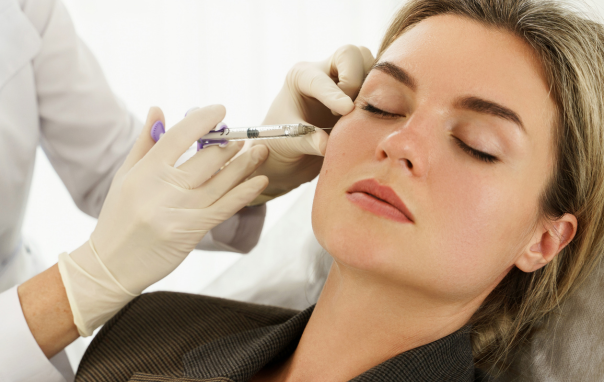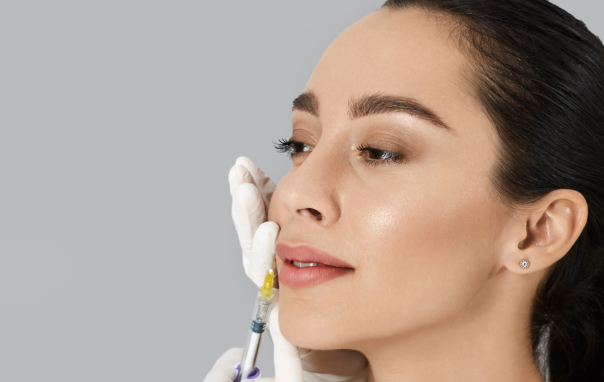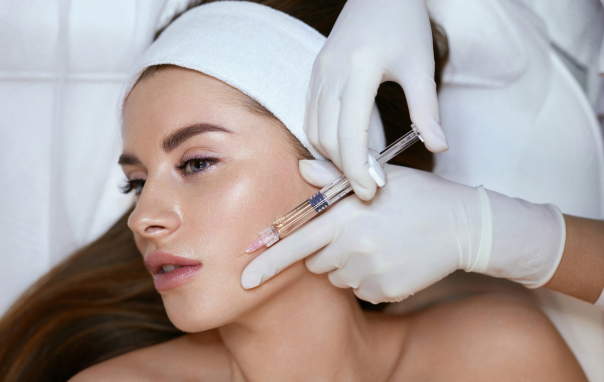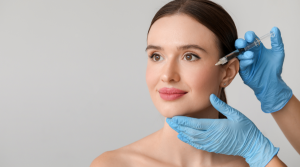Dermal fillers have become one of the most popular and effective cosmetic treatments for restoring a youthful appearance and enhancing facial contours.
Whether you’re looking to add volume to your cheeks, smooth out fine lines, or rejuvenate your overall facial appearance, dermal fillers offer a versatile solution.
This blog will explore how dermal fillers work on the face, the benefits they provide, and why they have become a go-to option for many seeking non-surgical facial enhancements. Additionally, we’ll discuss the types of dermal fillers, how they are used in various areas of the face, and what you can expect from a dermal filler treatment at Beauty Aesthetics in Toronto. For those considering dermal fillers Toronto offers safe and effective alternatives to surgery, with immediate effects and a smooth settling process post-treatment.
What Are Dermal Fillers?
Dermal fillers are injectable fillers made from various substances that are used to fill in wrinkles, add volume to soft tissue, and enhance facial contours. Unlike plastic surgery, which requires incisions and a longer recovery time, dermal fillers offer a non-invasive alternative with immediate results and minimal downtime. These injectable fillers are commonly used for facial volume restoration and aesthetic enhancement, addressing concerns such as volume loss, deep lines, and sagging skin that occur as part of the natural aging process.
Understanding the Role of Hyaluronic Acid in Dermal Fillers
One of the most common ingredients in dermal fillers is hyaluronic acid. Hyaluronic acid is a naturally occurring substance in the human body that plays a critical role in maintaining skin hydration and volume. As we age, the production of hyaluronic acid decreases, leading to volume loss, facial wrinkles, and a less youthful appearance. Hyaluronic acid fillers work by attracting and holding water in the skin, which helps to restore lost volume and add volume where needed.

Cheek Dermal Fillers: Enhancing Facial Contours
One of the most popular uses of dermal fillers is for enhancing the cheeks. Cheek dermal fillers are specifically designed to add volume to the mid-face area, which can become hollow or sunken due to the loss of facial fat and collagen as we age. By restoring facial volume to the cheeks, dermal fillers enhance the overall balance and harmony of the face, giving it a more youthful and lifted appearance.
How Cheek Dermal Fillers Work
Cheek dermal fillers are typically composed of hyaluronic acid or other volumizing agents. When filler injected into the cheeks, they immediately start to fill in hollow areas, lift sagging skin, and create a smoother, more contoured appearance. The results are often subtle yet noticeable, providing a natural looking result that enhances your natural beauty without the need for surgery.
Benefits of Cheek Dermal Fillers
- Restores Youthful Fullness: Cheek dermal fillers restore the youthful fullness that is lost over time, giving the face a rejuvenated and refreshed look.
- Improves Facial Contours: By adding volume to the cheeks, dermal fillers help to create a more defined and aesthetically pleasing facial contour.
- Non-Surgical and Minimally Invasive: Unlike surgical options, cheek dermal fillers require no incisions, general anesthesia, or lengthy recovery time.
- Immediate Results: Patients can see the effects of cheek dermal fillers immediately after the filler injections.
How Dermal Fillers Work on Different Areas of the Face
Dermal fillers are versatile and can be used to treat various areas of the face, each with specific goals and outcomes.
Nasolabial Folds and Smile Lines
Nasolabial folds, also known as smile lines or parentheses lines, are the deep lines that run from the sides of the nose to the corners of the mouth. These lines can become more pronounced with age due to the loss of facial volume and elasticity. Injectable dermal fillers can soften these lines by adding volume to the area, creating a smoother and more youthful appearance.
Marionette Lines and Vertical Lines
Marionette lines are the lines that extend downward from the corners of the mouth, often giving the face a sagging or downturned appearance. Vertical lines can also appear around the lips, known as vertical lip lines. Dermal filler injections in these areas can lift the skin and smooth out wrinkles, improving facial harmony and reducing the appearance of a sad or tired expression.
Lips and Lip Enhancement
Lip fillers are a popular treatment for enhancing the volume, shape, and definition of the lips. Whether you have thin lips naturally or have experienced volume loss over time, injectable fillers can help create fuller, more defined lips. Hyaluronic acid facial fillers are often used for lip enhancement due to their ability to attract and retain moisture, resulting in soft, plump lips.
Under-Eye Area and Dark Circles
Dermal fillers can also be used to address volume loss and dark circles under the eyes. The under-eye area can become hollow or sunken with age, leading to a tired appearance. Injectable fillers can fill in these hollows, brighten the under-eye area, and provide a more rested and youthful look.
How Dermal Fillers Stimulate Collagen Production
While dermal fillers provide immediate volume and contouring effects, they also have long-term benefits by stimulating collagen production. Collagen is a protein that provides structure and support to the skin, keeping it firm and elastic. As we age, collagen production decreases, leading to sagging skin, wrinkles, and volume loss. Certain types of dermal fillers, such as those containing poly-l-lactic acid, work by stimulating the body’s natural collagen production, providing both immediate and lasting results.

Types of Dermal Fillers: Which One Is Right for You?
There are several types of dermal fillers available, each designed to address specific concerns and provide different results. Understanding the options can help you and your provider determine the best dermal fillers for your needs.
Hyaluronic Acid Fillers
Hyaluronic acid fillers are among the most popular and widely used injectable fillers. These fillers are made from a naturally occurring substance in the skin and are known for their ability to hydrate and add volume. Hyaluronic acid facial fillers are versatile and can be used in various areas of the face, including the cheeks, lips, and under the eyes. They provide immediate results and are considered safe for most skin types.
Poly-L-Lactic Acid Fillers
Poly-l-lactic acid fillers are a type of injectable dermal filler that stimulates collagen production over time. These fillers are typically used for treating deeper facial wrinkles, such as nasolabial folds and marionette lines, and for restoring facial volume. The results from poly-l-lactic acid fillers develop gradually and can last for up to two years, making them a good option for patients seeking long-lasting results.
Calcium Hydroxylapatite Fillers
Calcium hydroxylapatite fillers are made from a mineral-like compound found in bones and are used to treat moderate to severe wrinkles, such as deep nasolabial folds and frown lines. These fillers are also effective for adding volume to areas with significant volume loss. Calcium hydroxylapatite fillers are known for providing natural-looking results and stimulating collagen production.
Choosing a Dermal Filler
Choosing the right dermal filler can feel overwhelming, given the numerous options available. However, by considering a few key factors, you can make an informed decision that aligns with your aesthetic goals.
First, understand your concerns. Identify the specific areas of your face you want to address, whether it’s fine lines, wrinkles, or volume loss. This will help narrow down the types of dermal fillers that might be suitable for you.
Next, research the different types of dermal fillers available. Hyaluronic acid fillers, for instance, are popular for their hydrating properties and versatility, making them ideal for areas like the cheeks, lips, and under the eyes. Other options include calcium hydroxylapatite and poly-L-lactic acid, each with unique benefits and applications.
Consider the texture and density of the filler. Thicker fillers are often better for deeper wrinkles and areas requiring significant volume, while thinner fillers are more suitable for fine lines and subtle enhancements.
Think about the filler’s longevity. Some fillers, like hyaluronic acid, can last up to a year, while others may need more frequent touch-ups. Your desired duration of results will influence your choice.
Finally, consult with a qualified provider. A professional can assess your facial anatomy, discuss your goals, and recommend the best dermal filler for your needs. By following these steps, you can confidently choose a dermal filler that will help you achieve your desired look.

What to Expect During a Dermal Filler Treatment
If you’re considering dermal filler treatment at Beauty Aesthetics in Toronto, it’s important to know what to expect during the treatment session.
Consultation and Customized Treatment Plan
The process begins with a consultation with a qualified provider who will assess your facial anatomy, discuss your aesthetic goals, and recommend the best treatment plan. This may involve using a combination of injectable fillers to address different areas of the face and achieve a balanced, natural-looking result.
The Injection Process
During the injectable filler treatment, the provider will use a fine needle to inject the filler into the targeted areas. The filler injected will immediately start to restore lost volume, smooth out wrinkles, and enhance facial contours. Numbing cream or local anesthesia may be applied to minimize discomfort, and the entire procedure typically takes about 30 minutes to an hour, depending on the number of areas being treated.
Aftercare and Recovery
After the filler injections, you may experience mild bruising, swelling, or mild discomfort in the treatment area. These side effects are temporary and usually resolve within a few days. It’s important to follow the provider’s aftercare instructions, which may include avoiding sun exposure, strenuous exercise, and certain skincare products for a short period. Most patients can resume their normal activities immediately after the treatment.
How Long Do Dermal Fillers Last?
The longevity of dermal fillers depends on the type of filler used, the area treated, and the individual’s metabolism. Hyaluronic acid fillers typically last between 6 to 18 months, while poly-l-lactic acid fillers can last up to two years. Calcium hydroxylapatite fillers also provide long-lasting results, with effects lasting around 12 months or more. Regular maintenance treatments are recommended to maintain the desired results.
Are Dermal Fillers Safe?
Dermal fillers are generally considered safe when administered by a qualified and experienced provider. The FDA-approved fillers used at Beauty Aesthetics in Toronto are made from biocompatible materials that are well-tolerated by the body. However, as with any medical procedure, there are potential risks, including infection, allergic reaction, and asymmetry. To minimize these risks, it’s essential to choose a reputable clinic with a track record of successful filler treatments.
Risks and Side Effects
While dermal fillers are generally safe, it’s important to be aware of potential risks and side effects. Understanding these can help you make an informed decision and prepare for your treatment.
Common side effects include mild swelling and bruising at the injection site. These are usually temporary and resolve within a few days. Applying ice and following aftercare instructions can help minimize these effects.
Allergic reactions, though rare, can occur. Some individuals may be allergic to the filler material or the lidocaine used to numb the area. It’s crucial to discuss any allergies with your provider before the treatment.
Infection is another risk, as with any invasive procedure. Ensuring that the treatment is performed in a sterile environment by a qualified provider can significantly reduce this risk.
Asymmetry can happen if the filler is not evenly distributed, leading to an uneven appearance. Choosing an experienced provider can help minimize this risk and ensure a balanced result.
Lastly, there is a small risk of nerve damage, which can cause numbness, tingling, or pain. This is rare but underscores the importance of selecting a skilled and experienced provider.
By being aware of these potential risks and side effects, you can take steps to ensure a safe and successful dermal filler treatment.
Choosing a Qualified Provider
Selecting a qualified provider is crucial for a safe and effective dermal filler treatment. Here are some tips to help you make the right choice.
First, look for board certification. Choose a provider who is board-certified in dermatology or plastic surgery. This certification ensures that the provider has undergone rigorous training and meets high standards of care.
Check their experience. Ensure that the provider has extensive experience with dermal fillers and has performed the procedure many times. An experienced provider is more likely to deliver natural-looking results and handle any complications that may arise.
Read reviews from previous patients. Online reviews can provide insights into the provider’s reputation and skill level. Look for consistent positive feedback and any red flags that might indicate potential issues.
Ask about their qualifications. Don’t hesitate to inquire about the provider’s training, qualifications, and experience with dermal fillers. A reputable provider will be transparent and willing to share this information.
Finally, check their facility. Ensure that the provider’s clinic is clean, safe, and well-equipped. A well-maintained facility reflects the provider’s commitment to patient safety and quality care.
By following these tips, you can choose a qualified provider who will help you achieve your aesthetic goals with confidence.
Dermal Fillers Cost: What to Expect
The dermal fillers cost can vary depending on several factors, including the type of filler used, the amount needed, and the specific areas being treated. On average, the cost of dermal filler injections ranges from $500 to $2,000 per syringe. Cheek dermal fillers and lip fillers typically require one to two syringes per treatment, while larger areas, such as the nasolabial folds, may require more. During your consultation at Beauty Aesthetics in Toronto, you will receive a personalized cost estimate based on your treatment plan.
Injectable Fillers vs. Surgical Options
When it comes to facial rejuvenation, injectable fillers offer a popular alternative to surgical options. Here are some key differences to consider.
Recovery time is significantly shorter with injectable fillers. Most patients can resume normal activities immediately after treatment, whereas surgical options often require a longer recovery period.
Injectable fillers are generally considered safer than surgical options, with fewer risks and side effects. While both procedures carry some risk, the non-invasive nature of fillers makes them a more appealing choice for many.
Cost is another factor. Injectable fillers are often less expensive than surgical options, making them accessible to a wider range of patients. However, keep in mind that fillers may require maintenance treatments to sustain results.
Results from injectable fillers are immediate, providing instant gratification. In contrast, surgical options may take longer to show final results due to swelling and healing time.
Lastly, injectable fillers are reversible. If you’re not satisfied with the results, hyaluronic acid fillers can be dissolved with an enzyme called hyaluronidase. Surgical options, on the other hand, are permanent and not easily reversible.
By understanding these differences, you can make an informed decision about whether injectable fillers or surgical options are the best choice for your facial rejuvenation needs.
Why Choose Beauty Aesthetics in Toronto for Dermal Filler Treatments?
At Beauty Aesthetics in Toronto, we are committed to providing high-quality dermal filler treatments that enhance your natural beauty and help you achieve your aesthetic goals. Our experienced providers use the best dermal fillers available and follow the latest techniques to ensure natural-looking results with minimal downtime. Whether you’re interested in cheek dermal fillers, lip enhancement, or facial contouring, our team will work with you to create a customized treatment plan that meets your needs.
Conclusion: The Power of Dermal Fillers for Facial Rejuvenation
Dermal fillers are a powerful tool for restoring youthful fullness, enhancing facial contours, and addressing the signs of aging. Whether you’re looking to smooth out deep lines, add volume to the cheeks, or create fuller lips, injectable fillers offer a versatile and effective solution. With minimal downtime, immediate results, and a high level of safety, it’s no wonder that dermal fillers have become one of the most popular cosmetic treatments worldwide.
If you’re considering dermal fillers and want to learn more about how they can benefit you, we invite you to schedule a consultation with Beauty Aesthetics in Toronto. Our team of experts will guide you through the process, answer any questions you may have, and help you achieve the rejuvenated appearance you’ve been looking for.
Frequently Asked Questions (FAQs)
How long do cheek dermal fillers last?
Cheek dermal fillers typically last between 12 to 18 months, depending on the type of filler used and the individual’s metabolism. Regular maintenance treatments can help extend the results.
Are there any side effects of dermal fillers?
Common side effects of dermal filler injections include mild bruising, swelling, and mild discomfort at the injection site. These side effects are usually temporary and resolve within a few days.
Can dermal fillers be dissolved if I don’t like the results?
Yes, hyaluronic acid fillers can be dissolved with an enzyme called hyaluronidase if you are not satisfied with the results. This allows for adjustments or complete removal of the filler.
How much do dermal fillers cost?
The dermal fillers cost varies depending on the type of filler used, the amount needed, and the areas being treated. On average, the cost ranges from $500 to $2,000 per syringe.
Is there any downtime after a dermal filler treatment?
There is minimal downtime after a dermal filler treatment. Most patients can resume their normal activities immediately, although it’s recommended to avoid strenuous exercise and sun exposure for a short period.







